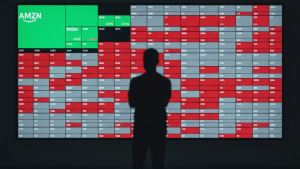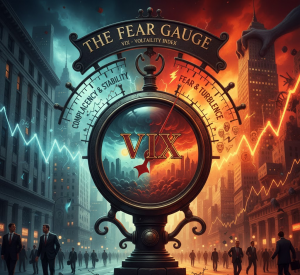Morning Market Snapshot – Tuesday, November 4, 2025
U.S. stock futures are pointing to a sharply lower open this morning, signaling a significant pause in market momentum. S&P 500 futures have slid 0.9%, while the tech-heavy Nasdaq 100 is leading the decline, down 1.2% in early trade.
Today’s focus is squarely on a reversal of sentiment. After a strong, AI-driven rally on Monday, optimism is waning. The retreat is being driven by a combination of weak U.S. manufacturing data and renewed uncertainty about the Federal Reserve’s policy path. Mixed signals from Fed officials regarding a potential December move have left traders feeling cautious.
Corporate earnings remain a primary catalyst. Palantir, a key name in the AI space, dropped nearly 3% in extended trading after its report, despite beating Wall Street estimates. This post-earnings volatility, even after a beat, highlights a nervous market where high expectations are difficult to satisfy. Traders are now assessing whether this pullback is a healthy consolidation or the start of a deeper correction as macroeconomic headwinds build.
Pre-Market News Catalysts
Here are the key individual stocks making headlines before the bell:
- Kenvue (KVUE): Shares of the consumer health company soared 20% in pre-market trading. The massive rally comes on news that Kimberly-Clark (KMB) will acquire the maker of Tylenol and other drugs in a $48.7 billion deal.
- Kimberly-Clark (KMB): Conversely, shares of the acquiring company tumbled nearly 15%. The negative reaction suggests investors are wary of the deal’s price tag or the strategic fit of combining the two consumer giants.
- Palantir (PLTR): The AI and data analytics firm is exhibiting significant volatility. The stock initially fell almost 3% in after-hours trading following its earnings report, despite exceeding analyst expectations. However, it has since reversed those losses, with pre-market data showing the stock up over 3% as investors digest the report. This whip-saw action makes it a critical stock to watch at the open.
- Fortis Inc. (FTS): The utility holding company is in focus as it reports third-quarter 2025 results today.4 Fortis also unveiled a new, larger five-year capital plan of $28.8 billion, an increase of $2.8 billion from its prior plan, and announced a 4% increase in its fourth-quarter dividend.
The Day’s Debate: The Bull vs. Bear Case
Analysts are deeply divided on the market’s next move. The tension between strong corporate performance and a deteriorating macroeconomic backdrop is at a breaking point.

The Bull Case: Optimists are focused almost exclusively on corporate earnings, which continue to defy broader economic concerns. With roughly 63% of S&P 500 companies having reported, third-quarter earnings growth is on pace for a 10% expansion. This figure is significantly above the 7% growth that was forecast at the end of the last quarter. This robust profitability is seen as the primary engine for the market.
Furthermore, strategists argue that this bull market, which began in October 2022, is “neither a toddler nor a senior citizen.” History suggests bull markets do not simply die of old age. Instead, they are typically ended by recessions or aggressive Federal Reserve tightening. Bulls contend that neither of these conditions appears likely in the near term, giving the rally more room to run. On a micro level, technicians are also finding reasons for optimism, pointing to specific stocks like Sun Pharmaceutical that are breaking out of consolidation patterns and appear poised to resume their uptrend.

The Bear Case: Pessimists are looking past the strong earnings and focusing on gathering macroeconomic storms. Their argument is threefold: credit, labor, and policy.
First, significant cracks are appearing in the credit system. The recent bankruptcies of Tricolor Holdings and First Brands have forced major banks like JPMorgan, UBS, and Jefferies to record significant write-offs. More worryingly, delinquency rates for office commercial real estate (CMBS) have now climbed above the peaks seen during the 2008 Great Financial Crisis.
Second, the labor market is slowing dramatically. Job growth averaged fewer than 30,000 new positions per month between June and August. Private-sector indicators like the ADP report have even shown net job losses. Bears warn that employment could turn negative this month, which would severely pressure consumer confidence and spending.
Finally, ongoing trade policy and tariffs are creating a stagflationary environment of slow growth and high inflation. J.P. Morgan research highlights that a “significant pass through [from tariffs] is coming that’s gonna squeeze US household purchasing power” and damage corporate profit margins. This policy is also contributing to the idea that the “US exceptionalism” which has powered its markets for years is now fading.
The Strategic Takeaway
The market is currently a battlefield between a strong micro-narrative (earnings) and a weak macro-narrative (credit, labor, policy). The resilience of corporate profits has been impressive, but it is running directly against mounting headwinds that squeeze the consumer and threaten financial stability. The most important thing to watch today is whether the tech-led pullback deepens. This could signal that investors are finally shifting their focus from strong earnings reports to the growing cracks in the underlying economy.
Upcoming Session Outlook
Slightly bearish/sideways for the open: the tone is cautious, futures are weak, and although upside remains in selected names, broader indices may struggle for direction until fresh catalysts emerge.
Disclaimer: This article is for informational purposes only and does not constitute financial, investment, or legal advice. The information provided is a synthesis of publicly available data and expert analysis and should not be considered a recommendation to buy or sell any security. Investing in the stock market involves risk, including the possible loss of principal. Past performance is not indicative of future results. Readers should consult with a qualified financial advisor to determine an investment strategy that is suitable for their own personal financial situation and risk tolerance.






















